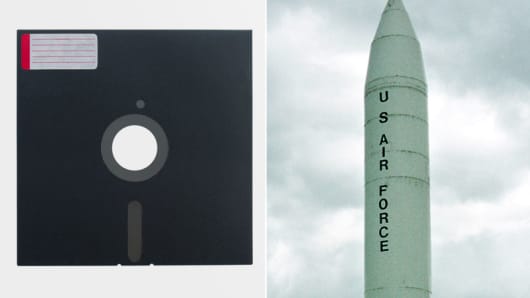This may be especially true of systems used for the disposition of nuclear weaponry. And as anyone who has lived through a technological 'upgrade' can tell you, it's usually not without some 'issues...' JL
Dan Mangan reports in CNBC:
The Defense Department's 1970s-era IBM Series/1 Computer and long-outdated floppy disks handle functions related to intercontinental ballistic missiles, nuclear bombers and tanker support aircraft.
"Federal legacy IT systems are becoming increasingly obsolete: Many use outdated software languages and hardware parts that are unsupported," the report found. "Agencies reported using several systems that have components that are, in some cases, at least 50 years old."Defense has plans to upgrade its nuclear-related technology system soon. Lt. Col. Valerie Henderson, department spokeswoman, said: "This system remains in use because, in short, it still works. However, to address obsolescence concerns, the floppy drives are scheduled to be replaced with Secure Digital devices by the end of 2017. Modernization across the entire Nuclear Command, Control, and Communications (NC3) enterprise remains ongoing."
Other agencies are moving toward that more slowly, at best. More than 75 percent of $80 billion budgeted for federal IT efforts across all agencies in fiscal 2015 was spent on operations and maintenance investment, and such spending has increased in the past seven years, GAO noted.
In contrast, spending on "development, modernization and enhancement" of federal IT systems has declined, according to GAO.
The office noted that the government plans to require agencies to identify which IT systems need to be updated, and then modify them. But until then, the GAO warned, "the government runs the risk of maintaining systems that have outlived their effectiveness."
In testimony to Congress on Wednesday, the chief technology officer of the IRS said that although the agency continues to operate a number of older IT systems, "it is not our preference to do so."
"Our ultimate goal is to retire all of them as quickly as possible," said Terence Milholland, the IRS tech officer.
GAO pointed out that aging systems include the Treasury Department's "individual master file," which is the authoritative data source for individual taxpayers. It's used to assess taxes and generates refunds. That file "is written in assembly language code — a low-level computer code that is difficult to write and maintain — and operates on an IBM mainframe," the report said.
Treasury's master business file, which contains all tax data on individual business income taxpayers, likewise is written in that same assembly language code, which was first used in the 1950s, and maintained on the old-school IBM mainframe.
While Treasury has general plans to replace the systems, "there is no firm date associated with the transition," GAO's report said.
In addition to Defense, the departments of Treasury, Commerce, Health and Human Services and Veterans Affairs "reported using 1980s and 1990s Microsoft operating systems that stopped being supported by the vendor more than a decade ago," GAO said.
And the Social Security Administration "reported rehiring retired employees to maintain its" systems which use COBOL, the computer programming language which was widely used — in the 1970s — according to GAO.
COBOL is also used by the Justice Department in its program to provide information about prison inmates, and the VA, which uses it for employee timekeeping and to track veterans' benefits claims and dates of death, the report said.





















0 comments:
Post a Comment